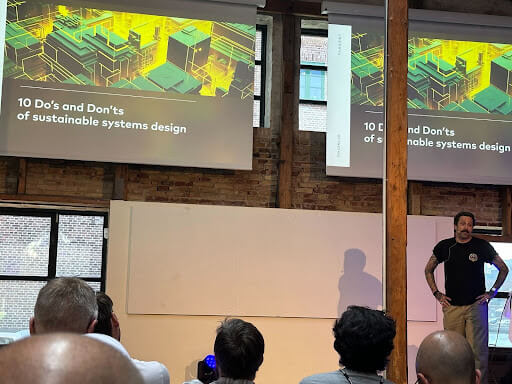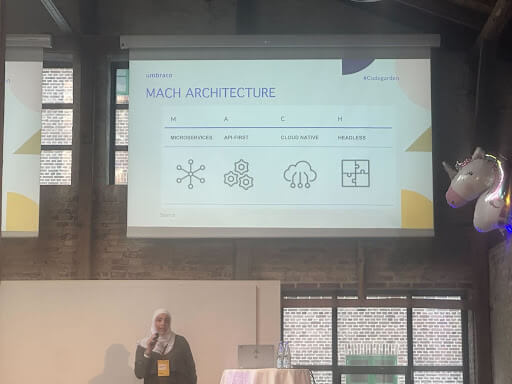Among other stuff, we're talking Umbraco V12, headless, improvements in Umbraco cloud, sustainability, web components, MACH, debugging and the Royal Navy!
Innerworks is coming soon...
This blog was originally published on our previous Cogworks blog page. The Cogworks Blog is in the process of evolving into Innerworks, our new community-driven tech blog. With Innerworks, we aim to provide a space for collaboration, knowledge-sharing, and connection within the wider tech community. Watch this space for Innerworks updates, but don't worry - you'll still be able to access content from the original Cogworks Blog if you want.
Codegarden is the international Umbraco conference that's packed with the biggest congregation of Umbraco users, thought leaders and developers worldwide.
Last week's conference in Odense, Denmark, marked the second visit from Cogworks Head of Delivery, Kas, and the third for our Head of Development, Imran!
So, what's going on with Umbraco?
Here's a quick summary of what we know:
1. There are three key takeaways from the Umbraco Business Summit.
The business summit is the conference just before Codegarden launches; it's an exclusive event for Umbraco Gold Partners, Umbraco Premium Tech Partners and Umbraco Direct Customers. You can read more about what it means to be an Umbraco Gold Partner at our blog.
A few takeaways:
Umbraco V12 is nearly here. It's predicted to be publicly available on June 29th 2023 and has some exciting headless capabilities.
- Cool stuff is going on behind the scenes to get the Umbraco cloud into shape, providing a great selection of environments and more control of CI/CD.
- There is a new sustainability team at Umbraco HQ!
2. Sustainable systems matter.
Sustainable practices and technology should be a well-considered step in the project process.

Andy Ava Dale, a long-standing advocate for sustainable systems and Technical Director at Tangent, gave a talk that blew our minds! He shared some staggering stats about a project they've recently done that saved a ton of emissions when dealing with databases and servers.
Using a headless JAMstack approach, a recent Umbraco project saved the equivalent CO2 emissions of multiple flights between Copenhagen to Denmark back and forth! Of course, headless is always recommended on a use-case basis, but that is still an outstanding achievement.
Once we got our head around the stats, we dived into best practices in sustainable Umbraco development in headless and traditional CMS projects.
A quick way to do better is to compress images in the latest and most efficient format.
Formats like WebP and AVIF files in Umbraco are the way to go, reducing the load to minuscule measures and reducing emissions.
We're working on a package to compress images in the backoffice to optimise PNG format, which we hope to share more about soon.
3. Umbraco will use web components in V14 and we're trying it out now.
Umbraco 14 backoffice UI will be built with Web Components instead of angular JS, simplifying development, enhancing reusability, and ensuring broad compatibility across browsers and frameworks.
Although yet to be released publicly, developers are already building using components in the backoffice, meaning the Umbraco community has early access (and knowledge) ahead of its time. We wouldn't expect any less from the Umbraco community!
4. Contentment looks great.
While there's always a constant stream of high-quality Umbraco packages, Head of Delivery Kas particularly liked Contentment. Contentment is the multi-award winning Umbraco package that gives content editors much more control of the UI and UX in the backoffice!

It looks and feels like Umbraco and allows editors to customise backoffice previews and enter editorial notes (and drawings) for fellow content editors. It also has developer mode, which lets you apply custom tweaks to the code with UI and aliases. You can check out the package's full feature list here.
5. Ishraq's case study showcases MACH and Umbraco in action.
We've been talking a lot lately about how MACH principles are behind the most significant tech innovators in the digital world.

Founder & CTO at ApplezTech, Ishraq Al Fataftah, gave a fantastic talk about how Umbraco can sit within a MACH architecture and showed us all the possibilities that composability brings to the web by reflecting on the ApplezTech website journey.
Their company website is built with Umbraco Heartcore (Umbraco's headless CMS) in conjunction with Next.js to deliver content and quick insights. Israq's talk gave us food for thought and hands-on tips on accentuating the customer experience in our headless projects at Cogworks.
6. How to master debugging.
Head of Development Imran saw a version of Steve's talk at Umbraco Spark and decided to tell Steve how insightful it was and that it'd make a fantastic longer talk. Steve delivered an incredible speech at Codegarden on advanced Umbraco debugging a few months later and we're so glad he did!

Debugging sometimes receives a different amount of emphasis across varying educational programs.
Luckily, professional devs (especially those within the Umbraco community) understand debugging as an indispensable skill, so we were super chuffed to listen to this great, very technical talk, packed with tips about remote debugging and application insights that Umbraco teams everywhere can apply right now.
Once the recording is uploaded, this is a must-watch for all developers!
7. Ways to perfect the QA testing process with Playwright & Umbraco.
This talk by Nikolaj Geisle reaffirmed the continuous hype behind Playwright in the QA community.

Playwright is the gift that keeps on giving, particularly when it comes to the quality of flaky tests, as Playwright can run the whole test before providing you result, and it has retries built into it, which not all frameworks have.
We're big fans of Playwright for automated testing; QA pro Mateusz recently shared how Playwright has significantly impacted his QA work at Cogworks. The tool interacts with hard-to-reach elements, which can better simulate user interactions, improving the reliability and effectiveness of tests and reducing the number of critical bugs encountered. In our recent post, you can read more about the tools we use for automated testing.
8. The Royal Navy got the app they needed.
Using Umbraco, the Royal Navy created the MyNavy app that handles traditionally paper-heavy HR responsibilities. The previously analogue way of working caused havoc for the organisation, causing dips in staff retention.
Head of Delivery Kas found this talk an excellent example of the importance of introducing key end users in the requirement stage of building a feature using Umbraco.
When staff members log in, they're presented with features they helped to build, which, aside from the app's ability to work offline (a handy requirement when your miles out to sea), explains why the application is used by 72% of the Royal Navy.
9. The Umbraco Community still got it.
Developer conferences can be pretty dull sometimes, but you can always rely on the Umbraco community to squash that generalisation with high-energy events running throughout the day, like Umbraco bingo, Olympic events, and spontaneous games of…we don't even know what that is pictured below.

Quirky games aside, the people at Cogdarden are MVPS, Gold Partner agencies and Umbraco strategists who work every day with great enthusiasm to build upon the world's friendliest CMS, so we don't begrudge them a little celebration, even if it's a little out there.
10. Codegarden blues is a thing.
Like many attendees, we have a case of the Codegarden blues right now, but it's picked us up reading all the interesting accounts from others at the event!
We hope you found this roundup helpful; get in touch to chat about applying the latest Umbraco insights and best practices to your project today.
Until next time,
Cogworks.
- Codegarden
- Umbraco
